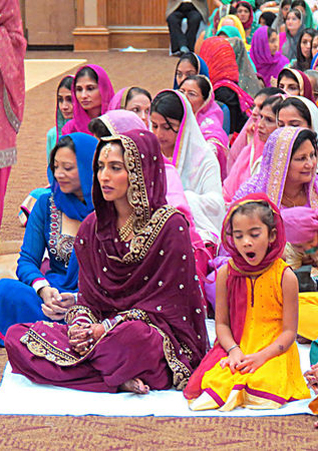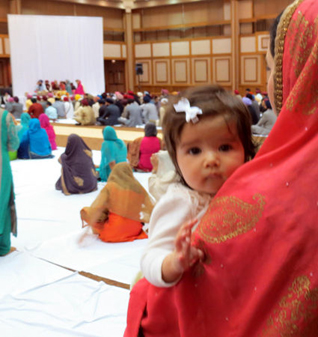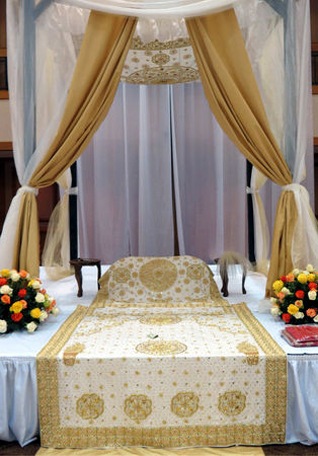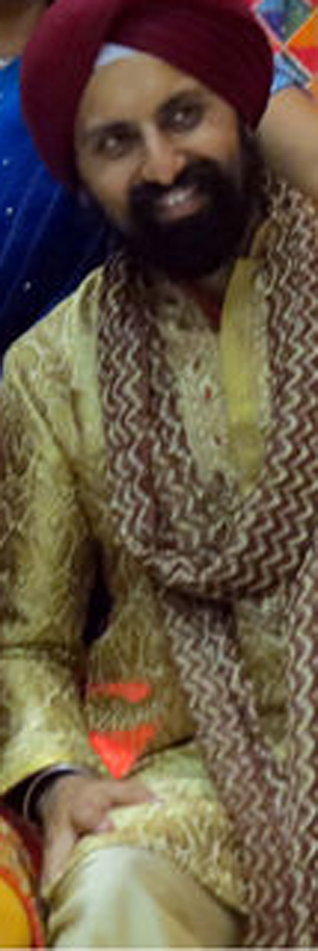People
A Wedding in Alabama
KAY CAMPBELL
Huntsville, Alabama, USA
The evening when Dr. Ravinder Singh Gogia, a dermatological surgeon, asked Sunaina Kaur Mehta, who grew up in Huntsville, Alabama, to marry him, the setting could not have been more romantic -- or more apt for their shared histories as bridge-building first-generation Americans.
Sunaina remembers that they were overlooking the Golden Gate Bridge, that great Western gate to the United States. A treasury management specialist for the Bank of America, she had been introduced to the tall surgeon nearly a year before when mutual friends had brought them together for a double date.
Both Ravinder and Sunaina are the children of professionals who grew up in Punjab, survived the chaos of the Partition of Punjab when Pakistan was formed, and immigrated to the United States. And both are devout Sikhs, members of the religion that developed in the late 15th century in the Punjab. Under the teachings of founder Guru Nanak, the faith emphasizes monotheism and respect and equality for all people without regard to caste, creed or gender.
Their wedding festivities were held in the Von Braun Center in Huntsville on Friday and Saturday, October 3 and 4, 2014.
Sunaina's father, NASA scientist Dr. Rajinder Singh Mehta, believes the gathering of more than 600 relatives and friends is probably one of the largest Sikh weddings to be held in the state of Alabama. The ceremonies were festive and dignified, playful and reverent. The guests wore a brilliant rainbow of bejeweled silks. The traditional music kept everything moving to beats that seemed at once ancient and new. The family heirloom drapes were incorporated into the huge chuppah that sheltered the scripture stand.
WEDDING STEPS
Friday's Evening Sangeet: Engagement party perfumed with the spicy aroma of Punjabi cuisine. The groom's parents arrived with gifts for the bride. There was traditional singing and dancing, and the exchange of rings between the bride and the groom.
Wedding Day Baraat and Milnee: The groom's family, led by a drummer and moving to the beat of traditional music played through a sound system wired to an SUV's battery, came dancing through a back access lot to the Von Braun in an exuberant Baraat.
The groom, wearing a silver veil to signify the blessings of his family, rode a white horse and carrying a sword.
For the Milnee, meeting, the bride's family - after sending out scouts who playfully stole the groom's shoes - met the groom's family and shared prayers for the guidance of the upcoming marriage.
Meanwhile, the bride was dressing with the help of her sister, Dr. Madhu Kaur Singh, and friends, who made sure each piece of her symbolic jewellery was in place and that the beaded scarf that covered her hair was perfectly draped.
Wedding Ardaas, Prayers: For the wedding ceremony, the main platform was reserved for the Guru Granth, the holy scriptures of Sikhism, not for the couple. Someone attended the Scripture with the attention due a king.
As guests entered, they offered a symbolic offering of money, and then bowed in reverence to the teachings before being seated on men's or women's side. All covered their heads out of respect for the Scripture. The bride and groom were the last to enter.
While Sikhs have religious scholars they look to for teaching, they have no clergy. Each Sikh, male and female, is expected to be able to sing the scriptures. Traditional music for the ceremony came from young people who have all worked at a summer camp for Sikhs in Tennessee.
Sikhia, Teaching: Sangeeta Kaur, a longtime friend of the bride who has, gave a short talk pointing to teachings from the scriptures as guides for the couple in their marriage and to remind them of their duties as Sikhs.
Laavan, Vows: The bride's father handed the end of the groom's pallaa (scarf) to the bride to signify their coming together as one. After the reading of each of the four vows, the couple, each holding the pallaa, made a careful circuit of the scriptures, a walk that signifies the beginning of their spiritual journey together.
Langar: At the end of the service, all are served sweet dough as a sacrament, a symbol of accepting the readings and also of the equality of all to eat together.
[Courtesy: AL.com. Edited for sikhchic.com]
October 8, 2014
Conversation about this article
1: Gurmeet Kaur (Chicago, Illinois, USA), October 14, 2014, 2:18 PM.
Why does the bride follow the groom while doing the laavan?
2: Onkar Singh (London, United Kingdom), October 14, 2014, 3:07 PM.
No particular reason. Certainly, there is no requirement or expectation in Sikhi to do so and can be changed at will. I've been to a number of weddings where the laavan were carried out with the bride and groom doing the circumambulations by walking side-by-side. No one objected. No one should. In fact, the sangat approved of it on each occasion.
3: Gurmeet Kaur (Chicago, Illinois, USA), October 15, 2014, 3:03 PM.
Onkar Singh ji, why do Sikh men and women sit separately in the gurdwara?






